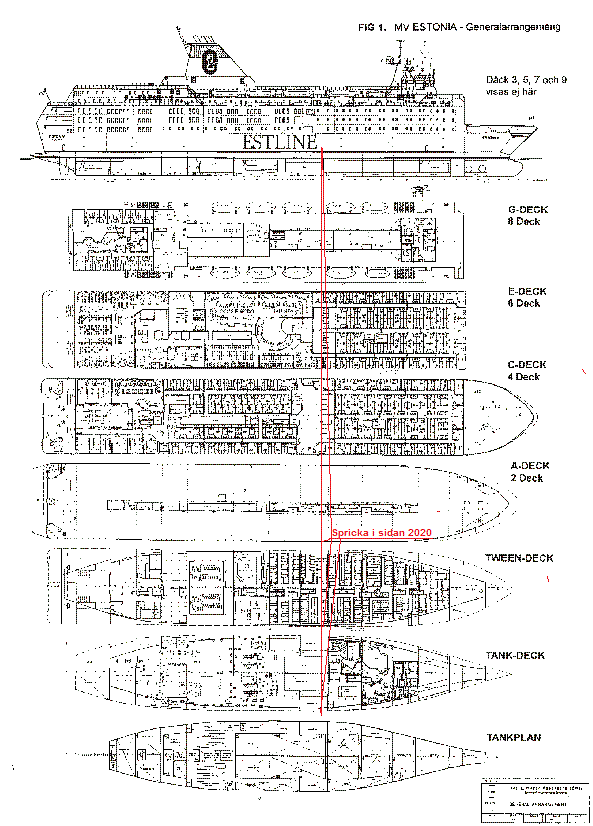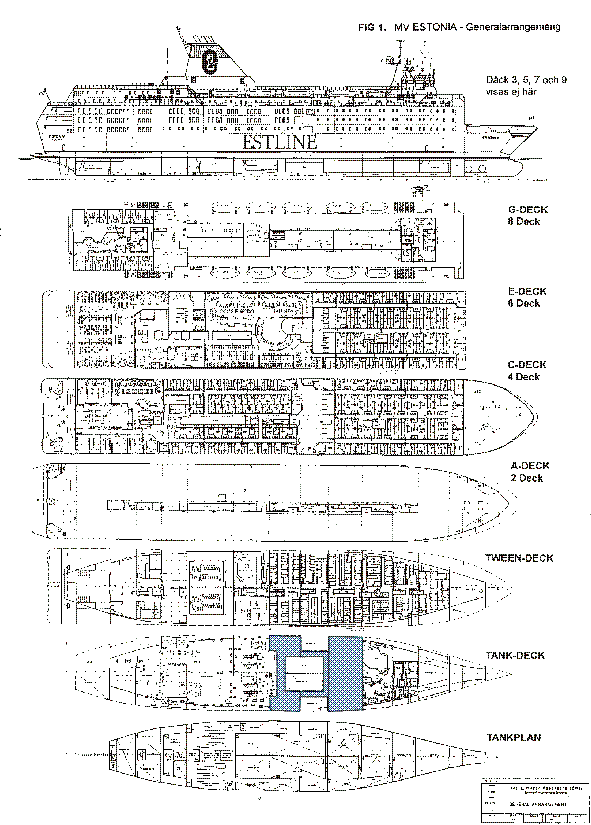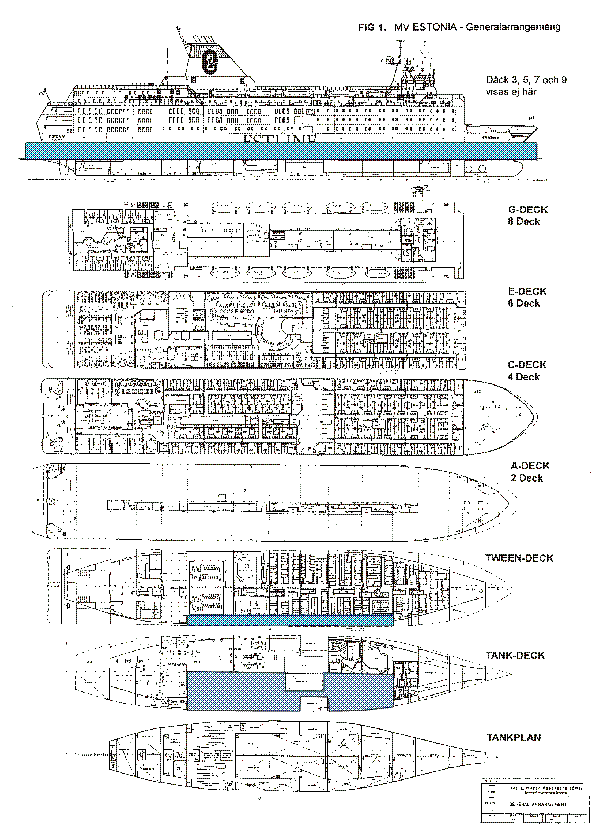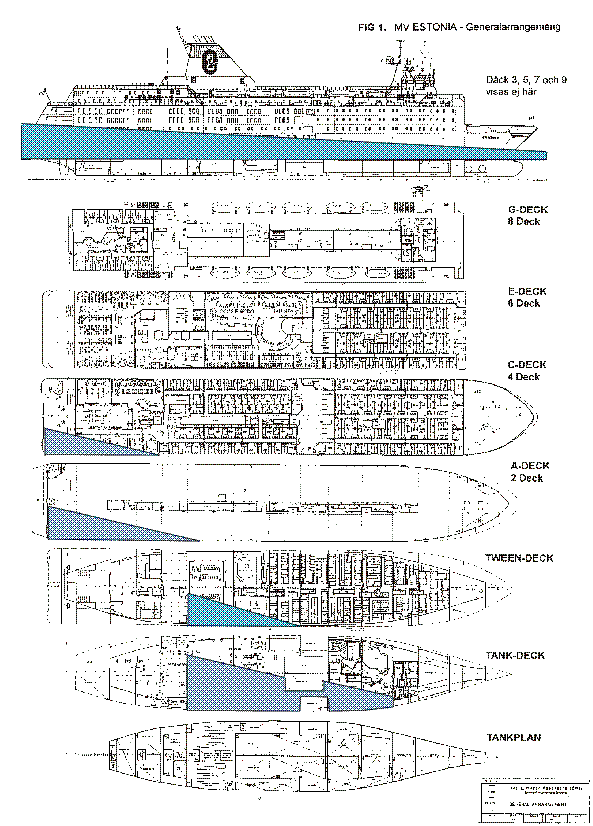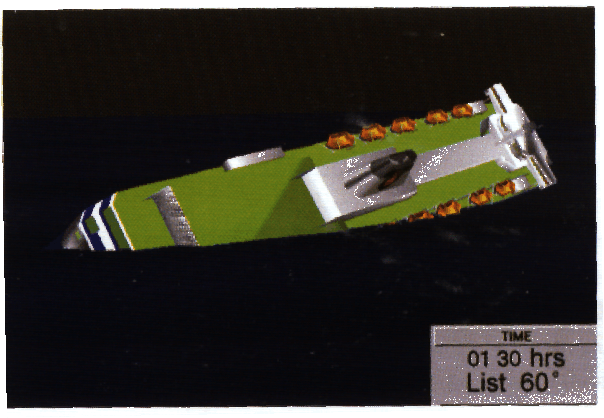2.26 Reconstruction of the last 46 Minutes. The Sinking
In the below plot (basically created in 1996) it was assumed that the official visor position was correct, which it is not the most probable case - the visor apparently hanged on to the bow until sinking and never fell off. It was also assumed that the speed was 15 knots on course 287°, but it is today (year 2001) also uncertain. It could be as simple that the vessel slowed down before the sudden listing occurred, i.e. the crew was well aware of a problem onboard, and that the ferry just sank due to leakage, flooding of several watertight hull compartments and open watertight doors. The plot is only included to show an early attempt to reconstruct the last 60 minutes.
The plot opens here Reconstruction .
Probably a more realistic 'plot' year 2004 is that the 'Estonia' never turns after the sudden listing but just stops and sinks due to a collision ... with the visor attached. But the below sequence of sinking may still be correct. The visor looks quite close to the waterline in the pictures (from the Final report (5))but it was in fact almost three meters above the waterline at the time of the accident. The mean draft was 5.2 meters, forward draft was 4.95 meters and the car deck was 2.65 meters above waterline forward.
|
Six Phases of the Sinking - Ramp always leaking 1. The General arrangement of the undamaged ship is seen right: The ship was apparently underway, when the accident occurred - it may have slowed down. The forward ramp on the car deck was always leaking, so water flowed into the superstructure when the visor dipped into waves (Source - the German Group of Experts). A watchman was checking the ramp. To enable the leaking water to flow out the crew operated the ship with a small, starboard list and stern trim. The small amounts of water that leaked in at the bow ramp in severe weather flowed aft along the starboard side of the car deck due to the stern trim and flowed out through the scuppers in the superstructure. This was 'normal' practice. Leakage develops 2. At 00.55 hrs the writer thinks the ship suffered hull damage below waterline - maybe in way of the starboard stabilizer fin box room or the starboard sewage tank compartment and the room was flooded. The hull damage was probably due to a collision. |
|
|
Two strong bangs had suddenly been heard all over the ship. The inflow might have been 100-200 ton/minute. The effective open area of the damage was about 0,3-0,5 m². Apparently the watertight doors to the two forward or aft spaces were open - a corridor space - so that three compartments were flooded. Alternatively (less likely) the starboard shell plating fractured in the bilge strake at the sauna or pool area. It was a rust trap. Water always spilled out from the swimming pool and ended up in the bilges, where the lower frame brackets were rusty (even if the pool is located on the port side). Passengers have reported that they had found the sauna/pool area flooded - 20 centimeters of water on the inner bottom - on earlier trips. The crew knew that something was wrong from the start and 3/E Treu was probably out of the control room to check. He must have reported to the bridge that the ship was leaking - that several compartments on deck 0 were flooded and it is assumed that the engine crew started the bilge pumps (one crew member said so) and closed some watertight doors. |
|
|
Water on Deck 1 - the sudden List develops 3. However - when the passengers on deck 1 informed the bridge (via the information counter on deck 5), that there was water on deck 1, the crew - probably including the Master - on the bridge panicked. The watertight door control panel on the bridge was badly arranged 1.23 - some indication lights had been arranged to be green, when the doors were open and some were red, when other doors were also open. In addition there was a facility to open, and to keep open, the watertight doors from the bridge (panel). It is thought that the Master tried to close all watertight doors, but by mistake some doors were instead opened at about 01.00 hrs - to the generator room aft and to the swimming pool room forward of the flooded compartments on deck 0 (tank top) causing two strong bangs.Thus the water - say about 600-1.000 tons - in the flooded three compartments spread to five compartments - 120-200 tons in each. Then the ship lost its initial stability due to too large free water surfaces causing negative GM 2.17 . |
|
|
The ship would still have been safe, albeit with a list, if the water could have been contained by closing the watertight doors and pumping the undamaged spaces dry. It tallies with survivors observation - the vessel stabilized with a 15-20 degrees list after the first deep rolls, sudden listing to starboard. One engine crew member has also stated - to CNN - that he was suddenly standing to his knees in water - it could very well have been in the generator room. Stable Condition after the sudden List 4. It is then thought that the watertight door in the centre line on deck 0 between the generator and engine rooms was also open and that water spilled into the main engine room at say about 01.12 hrs - six compartments flooding! The ship listed less and had only 12° degrees list for 10 minutes enabling evacuation until 01.18 hrs - and was still stable with say 800-1 200 tons of water on deck 0. The ship was now floating with help of the weathertight superstructure - the car deck between decks 2 and 4. Ramps and visor were in place. Only little water flowed in at the forward ramp. The situation looked as shown right: |
|
|
The Ship sinks on the Stern 5. But more water flooded in through the leak and the aft trim increased (watertight doors aft of engine room wre open) and deck 2 aft came below water and the superstructure was flooded via the partly open aft (!) ramp. What happened now was the following: as the ship listed the aft ramp openings, say open area 0.5 m², on deck 2 aft on top of the main deck came under water and water flooded through them onto the car deck 2 aft - say 200-300 ton/minute. As a result the ship started to trim on the stern, listed more, 20, 30 (Mayday is sent), 60, 90 and 120° and started to sink quickly stern first. Evidently the ship had been sinking since the leak started but now the situation was very serious. The water in the six compartments on deck 0 flowed to the stern. The situation at about 01.25 hrs may have been as seen right: The starboard pilot door of the superstructure may have been open, enabling water to enter the superstructure that way. The tragedy is that the ship could have still been saved in this condition by finally closing the watertight doors in the hull - and pumping the intact compartments dry. |
|
|
The final Sinking 6. Then the ship was doomed. The deckhouse and car deck were flooded more as seen on the figure right from the Final report. A ship can evidently not float in that position, but this the Commission suggests - the ship should have sunk 22 minutes later! The ship probably sank hitting the bottom already at say 01.32 hrs with the stern first, while the bow - probably with the visor in place - was above the water. As can be seen on the figures above there was a fair amount bouyancy left in the ship on decks 0 and 1 forward at this time. |
|
In order to verify the above scenario an associate of the writer informally inspected in August 2000 a ferry belonging to the owners of the 'Estonia' between Tallinn and Stockholm. All watertight doors below the car deck were open at sea. The Swedish Maritime Administration was duly informed - and decided to do nothing (except that the Director General - Mr. Anders Lindström - shortly afterwards decided to leave his position for other duties). It is sad that all parties do not encourage simple seamanship. Then similar accidents as the 'Estonia' will occur again, and again.
It is quite simple to verify the above scencario. Many modern ferries have sophisticated stability computers that not only calculates intact stability but also damage stabiliy, e.g. the Finnish Napa Onboard range of computers. The latter can be programmed to calculate the stability with flooded compartments. Thus you only have to start with an original, intact condition and then add water to the compartments you assume damage or flooded. The Napa Onboard immediately calculates the relevant new equilibrium and the relevant new particulars, draught, trim, displacement, GoM, GZ and range, list, etc. It will inform when the margin line is submerged and when progressive flooding starts.
|
The Napa Onboard computer can also be used to show what happens with water in the superstructure - at a certain angle of list the ship capsizes. Evidently the Napa Onboard computer assumes that the deck house does not contribute with bouyancy to float the ship - only a weathertight superstructure provides bouyancy when submerged to extend the range of positive heeling arm GZ. A certain amount of water only inside the superstructure always leads to capsize - right. |
|
